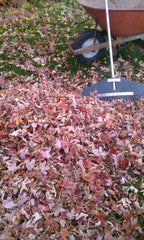It’s fall again and that’s when we are laden with the chores of raking leaves.
It makes no since to toss this potential black gold, Leaf Mold!
Leaf Mold greatly improves soil structure and water holding capacity by 50%.
It also creates the perfect condition for beneficial organisms that dwell in the soil.
Making leaf mold couldn’t be easier either!
When making leaf mold, one of the most important things to remember is moisture.
Without it, the break down process can be dauntingly long.
As with making compost, there are several ways to go about it.
One method, which we call the “Dump and Run”, is just simply that.
Find an inconspicuous spot in your yard and dump your leaves.
Give the leaves a sprinkle of water in layers.
If water is applied only to the top, it will repel off and never enter the center of the pile.
This method will take up to a year or more in dry climates to fully break down.
If you want quicker results, break down the leaves with a shredder or run a lawn mower over them.
The smaller the pieces, the faster the decomposition process will be.
Pile your leaves no smaller than a 3 x 3 pile.
Remember, bigger piles are always harder to handle.
We make several 3 x 3 piles in rows to make turning easier.
While piling your leaves distribute 2 cups of
blood meal or
organic soybean meal per pile along with a sprinkling of water.
Blood meal and
soybean meal are nitrogen, which is needed to speed up the composting process.
Dried fallen leaves no longer contain nitrogen, they are just carbon.
Turn every week and add water if your pile seems to be dry, but make sure you don’t get the pile to wet and soggy.
Like a rung out sponge is perfect!
If you want a tidier look, you can put the leaves in a cage made of chicken wire or other suitable bins, but we like the ease of turning these small piles without any restrictions.
Once the leaves no longer have a leaf structure look, are dark brown to black color and smell earthy, it’s time to use in the garden.
This method usually takes about two to three months, depending on how often the pile was turned, moisture content and weather conditions can also contribute.
Leaf mold can be used as mulch by simply layering around perennial flower beds or mulch vegetables or till leaf mold directly in your garden beds.
If you don’t want the hassle of making leaf mold, you can simple till leaves in your garden soil in the fall and let nature take its course. Through the winter months the leaves will break down naturally with the help of microorganisms that already exist in organic soil. You may have to water your garden if you don’t receive any natural moisture.
So why toss those leaves in the trash when you can create a great soil amendment!





Comments (0 Comments)
There are no comments.
Post Comment